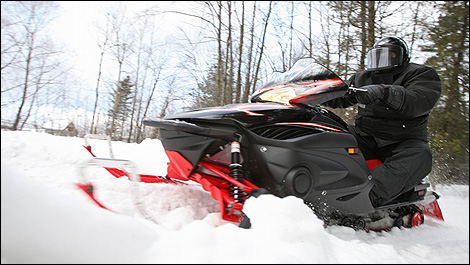Japanese manufacturer Yamaha offers more 4-stroke models than any competitor. These engines are not only environmentally friendly but also high performing. Thanks to its motorcycling expertise, Yamaha has become a master at creating powerful, efficient and clean engines.
The RS Vector LTX is motivated by one of the brand's best 4-stroke powerplants ever. Unlike that of the Apex, the 3-cylinder Genesis 120 was specifically developed and built for snowmobile applications. It features 12 valves and a double overhead camshaft for a power rating of 120 horsepower. In order to reduce costs and remain competitive from a pricing standpoint, Yamaha chose to retain the carburetor-based fuel delivery system, consisting of three 40-mm Keihin CVK carburetors.
 |
| Riding the RS Vector is incredibly fun. |
This engine is extremely smooth. It delivers a quality feel and a throaty exhaust note different from a traditional 2-stroke engine's yet very pleasant to the ears. The powerband is steady, while low- and mid-range torque is massive.
Powerful and easy to modulate, the Genesis 120 delivers the goods in the form of exciting, well-controlled accelerations. Throttle response is instantaneous and the engine never hesitates. Considering how smooth, quiet and torquey it is, the Genesis 120 is perfectly suited for a grand touring snowmobile like the RS Vector LTX. It's actually one of the best high-mileage engines in the industry, allowing you to travel hundreds of kilometers every day.
A more modern chassis While the old RS Vector offered a more traditional riding position, the new one is decidedly more modern thanks to the second-generation Deltabox chassis. True, when you look at the 2008 RS Vector for the first time, it's easy to confuse it with the top-of-the-line Apex. The reason is simple: the former borrows from the latter its Deltabox II architecture.
 |
| The Deltabox II chassis represents a significant improvement over the old generation. |

